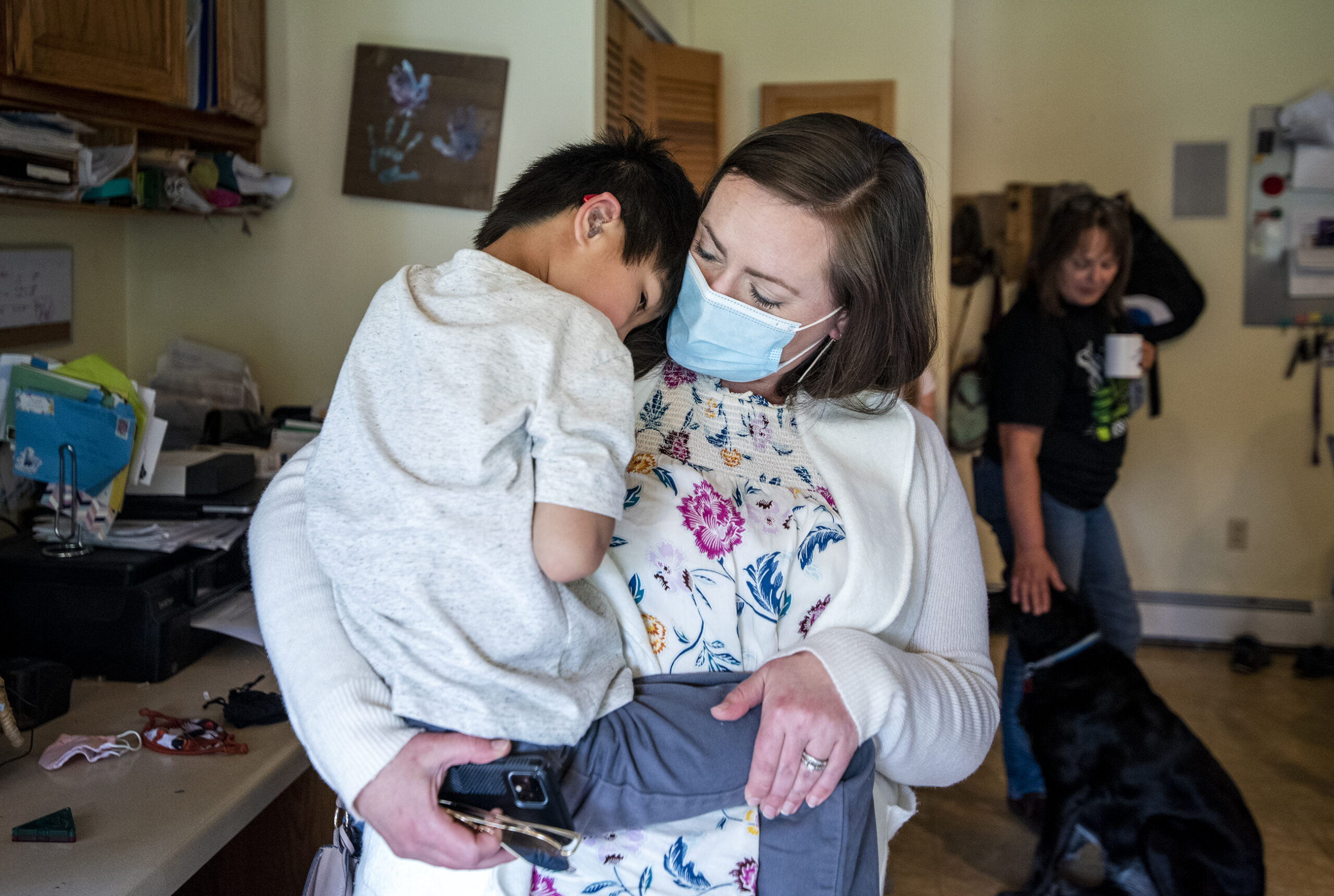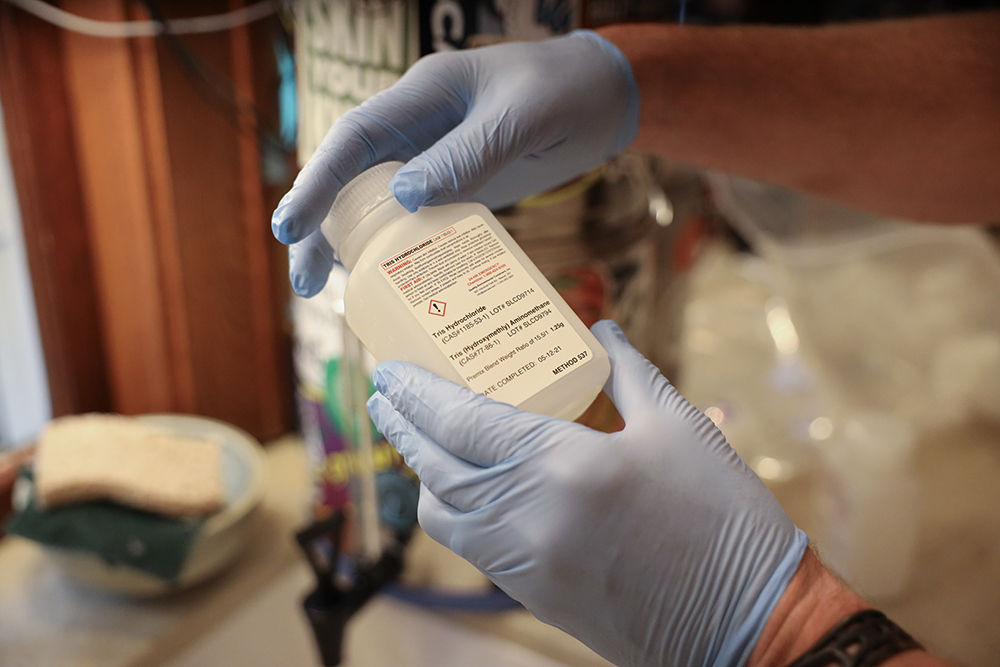After more than two years, the Wisconsin Natural Resources Board is set to take up proposed standards to regulate harmful “forever chemicals” known as PFAS in drinking water, surface water and groundwater later this month.
Federal regulators have been aware of the health hazards of PFAS for more than two decades. Even so, the Environmental Protection Agency has yet to develop standards for the chemicals. The Wisconsin Department of Natural Resources is proposing strict standards the agency argues will protect public health and the environment, warning federal standards are still years away.
Wisconsin environmental groups and residents affected by PFAS are at odds with water and industry groups over the DNR’s proposed regulations. Even so, there seems to be agreement that the chemicals should be regulated, said David Strifling, director of the Water Law and Policy Initiative at Marquette University Law School.
Stay informed on the latest news
Sign up for WPR’s email newsletter.
“I think there’s a general agreement that they should be regulated, that we don’t want to be ingesting them and distributing them throughout the environment, but what to do is a subject of much dispute,” Strifling said.
Here’s a rundown on what people should know about PFAS and the proposed standards that will be considered by the DNR’s policy-setting board Wednesday, Feb. 23.
[[{“fid”:”1588331″,”view_mode”:”full_width”,”fields”:{“alt”:”Foam is seen at Olbrich Park”,”title”:”Foam is seen at Olbrich Park”,”class”:”media-element file-embed-landscape media-wysiwyg-align-right”,”data-delta”:”1″,”format”:”full_width”,”alignment”:”center”,”field_image_caption[und][0][value]”:”%3Cp%3EFoam%20is%20seen%20at%20Olbrich%20Park%20in%20Madison%2C%20Wis.%2C%20where%20PFAS-tainted%20Starkweather%20Creek%20enters%20Lake%20Monona.%20Public%20Health%20Madison%20and%20Dane%20County%20has%20warned%20residents%20not%20to%20swallow%20the%20foam%20%E2%80%94%20or%20allow%20their%20pets%20to%20do%20so.%20%3Cem%3EIsaac%20Wasserman%2FWisconsin%20Watch%3C%2Fem%3E%3C%2Fp%3E%0A”,”field_image_caption[und][0][format]”:”full_html”,”field_file_image_alt_text[und][0][value]”:”Foam is seen at Olbrich Park”,”field_file_image_title_text[und][0][value]”:”Foam is seen at Olbrich Park”},”type”:”media”,”field_deltas”:{“1”:{“alt”:”Foam is seen at Olbrich Park”,”title”:”Foam is seen at Olbrich Park”,”class”:”media-element file-embed-landscape media-wysiwyg-align-right”,”data-delta”:”1″,”format”:”full_width”,”alignment”:”center”,”field_image_caption[und][0][value]”:”%3Cp%3EFoam%20is%20seen%20at%20Olbrich%20Park%20in%20Madison%2C%20Wis.%2C%20where%20PFAS-tainted%20Starkweather%20Creek%20enters%20Lake%20Monona.%20Public%20Health%20Madison%20and%20Dane%20County%20has%20warned%20residents%20not%20to%20swallow%20the%20foam%20%E2%80%94%20or%20allow%20their%20pets%20to%20do%20so.%20%3Cem%3EIsaac%20Wasserman%2FWisconsin%20Watch%3C%2Fem%3E%3C%2Fp%3E%0A”,”field_image_caption[und][0][format]”:”full_html”,”field_file_image_alt_text[und][0][value]”:”Foam is seen at Olbrich Park”,”field_file_image_title_text[und][0][value]”:”Foam is seen at Olbrich Park”}},”link_text”:false,”attributes”:{“alt”:”Foam is seen at Olbrich Park”,”title”:”Foam is seen at Olbrich Park”,”class”:”media-element file-full-width media-wysiwyg-align-center”,”data-delta”:”1″}}]]
What is PFAS?
PFAS, or perfluoroalkyl and polyfluoroalkyl substances, are a class of thousands of manmade chemicals found in firefighting foam and everyday products like nonstick cookware and stain-resistant clothing.
Where does PFAS come from?
PFAS was first invented in the 1930s, and the chemicals have been used by industry since the 1940s. Companies like Delaware-based DuPont and Minneapolis-based 3M manufactured products using PFAS chemicals, including the two most widely studied substances PFOA and PFOS.
What are the risks of PFAS?
The chemicals are concerning because they don’t break down easily in the environment. Multiple studies of people living and working in areas with high PFOA levels have shown links to serious health effects that include increased risk of kidney and testicular cancers, thyroid disease and fertility issues. The chemicals have also been tied to reduced response to vaccines.
Where has PFAS been found in Wisconsin?
As awareness of PFAS has grown, the scope of contamination has been more widely documented. As of last fall, the DNR said regulators were addressing PFAS pollution at more than 50 sites within 25 communities.
[[{“fid”:”1513611″,”view_mode”:”embed_landscape”,”fields”:{“format”:”embed_landscape”,”alignment”:”right”,”field_image_caption[und][0][value]”:”%3Cp%3EDale%20Wetterling%20empties%20a%20bag%20of%20ice%20into%20a%20box%20before%20placing%20it%20in%20the%20freezer%20Tuesday%2C%20June%201%2C%202021%2C%20at%20his%20home%20in%20French%20Island%2C%20Wis.%20He%20and%20his%20wife%2C%20Mary%2C%20use%20ice%20from%20Kwik%20Trip%20due%20to%20PFAS%20contamination%20in%20their%20water.%20%3Cem%3EAngela%20Major%2FWPR%3C%2Fem%3E%3C%2Fp%3E%0A”,”field_image_caption[und][0][format]”:”full_html”,”field_file_image_alt_text[und][0][value]”:”A man dumps a clear plastic bag of ice into a white box in a kitchen. “,”field_file_image_title_text[und][0][value]”:”PFAS French Island”},”type”:”media”,”field_deltas”:{“2”:{“format”:”embed_landscape”,”alignment”:”right”,”field_image_caption[und][0][value]”:”%3Cp%3EDale%20Wetterling%20empties%20a%20bag%20of%20ice%20into%20a%20box%20before%20placing%20it%20in%20the%20freezer%20Tuesday%2C%20June%201%2C%202021%2C%20at%20his%20home%20in%20French%20Island%2C%20Wis.%20He%20and%20his%20wife%2C%20Mary%2C%20use%20ice%20from%20Kwik%20Trip%20due%20to%20PFAS%20contamination%20in%20their%20water.%20%3Cem%3EAngela%20Major%2FWPR%3C%2Fem%3E%3C%2Fp%3E%0A”,”field_image_caption[und][0][format]”:”full_html”,”field_file_image_alt_text[und][0][value]”:”A man dumps a clear plastic bag of ice into a white box in a kitchen. “,”field_file_image_title_text[und][0][value]”:”PFAS French Island”}},”link_text”:false,”attributes”:{“alt”:”A man dumps a clear plastic bag of ice into a white box in a kitchen. “,”title”:”PFAS French Island”,”class”:”media-element file-embed-landscape media-wysiwyg-align-right”,”data-delta”:”2″}}]]
The chemicals have affected residents in communities both large and small, contaminating public and private wells.
People in towns like Peshtigo and Campbell have been forced to rely on bottled water due to PFAS contamination of private wells that stems from the use of firefighting foam containing the chemicals. Cities like Madison, Eau Claire, and La Crosse have shut down wells due to concerning levels of the chemicals in municipal wells. Wausau is the most recent city to report elevated levels of the chemicals in all its city wells.
What standards are being proposed by the DNR?
Gov. Tony Evers directed the agency to develop standards to address PFAS as part of an executive order issued in August 2019. The Natural Resources Board signed off on developing those standards in January the following year.
The DNR is proposing an individual and combined standard of 20 parts per trillion for PFOA and PFOS in drinking water, as recommended by the Wisconsin Department of Health Services. Nearby states have either proposed or put in place similar or more restrictive drinking water standards for PFAS, including Illinois and Michigan.
Meanwhile, the EPA announced a broad plan last fall to set federal drinking water standards. The agency has currently set a health advisory level of 70 parts per trillion.
[[{“fid”:”1500336″,”view_mode”:”full_width”,”fields”:{“alt”:”French Island Residents Pick Up Bottled Water”,”title”:”French Island Residents Pick Up Bottled Water”,”class”:”media-element file-embed-landscape media-wysiwyg-align-right”,”data-delta”:”3″,”format”:”full_width”,”alignment”:””,”field_image_caption[und][0][value]”:”%3Cp%3EFrench%20Island%20residents%20pick%20up%20bottled%20water%20on%20March%2025%2C%202021%2C%20over%20concerns%20of%20PFAS%20contamination%20in%20private%20drinking%20water%20wells.%26nbsp%3B%3Cem%3EHope%20Kirwan%2FWPR%3C%2Fem%3E%3C%2Fp%3E%0A”,”field_image_caption[und][0][format]”:”full_html”,”field_file_image_alt_text[und][0][value]”:”French Island Residents Pick Up Bottled Water”,”field_file_image_title_text[und][0][value]”:”French Island Residents Pick Up Bottled Water”},”type”:”media”,”field_deltas”:{“3”:{“alt”:”French Island Residents Pick Up Bottled Water”,”title”:”French Island Residents Pick Up Bottled Water”,”class”:”media-element file-embed-landscape media-wysiwyg-align-right”,”data-delta”:”3″,”format”:”full_width”,”alignment”:””,”field_image_caption[und][0][value]”:”%3Cp%3EFrench%20Island%20residents%20pick%20up%20bottled%20water%20on%20March%2025%2C%202021%2C%20over%20concerns%20of%20PFAS%20contamination%20in%20private%20drinking%20water%20wells.%26nbsp%3B%3Cem%3EHope%20Kirwan%2FWPR%3C%2Fem%3E%3C%2Fp%3E%0A”,”field_image_caption[und][0][format]”:”full_html”,”field_file_image_alt_text[und][0][value]”:”French Island Residents Pick Up Bottled Water”,”field_file_image_title_text[und][0][value]”:”French Island Residents Pick Up Bottled Water”}},”link_text”:false,”attributes”:{“alt”:”French Island Residents Pick Up Bottled Water”,”title”:”French Island Residents Pick Up Bottled Water”,”class”:”media-element file-full-width”,”data-delta”:”3″}}]]
“EPA is looking at that number and the rulemaking that it has underway, and so it’s not clear to me exactly where that will settle,” Strifling said. “But, again, that’s in that area of scientific disagreement between the opponents and supporters of this rule package: Where should we set that number?”
State regulators are also proposing a standard of 20 parts per trillion for the two chemicals in groundwater, as well as a preventive action limit of 2 parts per trillion. That level is used to trigger actions to prevent further contamination.
In surface water, the agency is proposing a standard of 8 parts per trillion for PFOS in all waters with limited exceptions. For PFOA, the DNR is recommending a standard of 20 parts per trillion in waters deemed public water supplies and 95 parts per trillion for all other surface waters.
Who wants state PFAS regulation and who doesn’t?
Water and industry groups have urged the DNR to wait for federal standards for drinking water rather than proposing statewide limits on PFAS. Those groups include the Wisconsin Rural Water Association, the Municipal Environmental Group’s Water Division, the Wisconsin League of Municipalities, Wisconsin Manufacturers and Commerce, Wisconsin Paper Council, American Chemistry Council and Midwest Food Products Association.
“Manufacturers that are multi-jurisdictional don’t want to have to deal with one standard in Minnesota, and another one in Wisconsin, and another one in Connecticut, and so on and so forth,” Strifling said.
Residents of PFAS-polluted communities and environmental groups have submitted comments saying state standards are sorely needed to protect public health and the environment. Those groups include Midwest Environmental Advocates, Clean Wisconsin, River Alliance of Wisconsin, Sierra Club of Wisconsin, Wisconsin Conservation Voters, and the League of Women Voters of Wisconsin.
“Some of the environmental and public health advocates would tell you that the numbers aren’t strict enough, (and) they should be lower,” Strifling said.

Why is the DNR proposing PFAS standards now?
The agency has 30 months to develop environmental regulations under the state’s rulemaking process. Since the agency launched the effort two years ago, time is running out.
“If the NRB declines to approve the rule, it seems to me that there’s a very real likelihood that (the) DNR would have to scrap this effort and go back to square one,” Strifling said.
Last fall, the agency said it was abandoning proposed nitrate standards in areas vulnerable to groundwater contamination because the DNR ran out of time.
How much would it cost to regulate PFAS?
For drinking water, the DNR anticipates it would cost businesses and local governments about $5.6 million in the first year and an average of $3.9 million annually in the years immediately following.
Environmental regulators say nine systems will likely exceed those standards and resort to treatment systems that could be financed through the state’s Safe Drinking Water Loan program. The nine systems are expected to cost $35.2 million over two decades plus maintenance costs of nearly $2 million each year.
For groundwater, the DNR expects the average cost of compliance would be roughly $2.6 million each year. For surface water, the agency estimates the maximum cost to meet the standard each year would be around $4.8 million.
[[{“fid”:”1634246″,”view_mode”:”embed_landscape”,”fields”:{“format”:”embed_landscape”,”alignment”:”right”,”field_image_caption[und][0][value]”:”%3Cp%3E%3Cem%3E%3Ca%20href%3D%22https%3A%2F%2Fwww.flickr.com%2Fphotos%2Fnathaninsandiego%2F%22%3ENathan%20Rupert%3C%2Fa%3E%20(CC%20BY-NC-ND%202.0)%20%3C%2Fem%3E%3C%2Fp%3E%0A”,”field_image_caption[und][0][format]”:”full_html”,”field_file_image_alt_text[und][0][value]”:”Kitchen sink with running water and dish soap”,”field_file_image_title_text[und][0][value]”:”Kitchen sink with running water and dish soap”},”type”:”media”,”field_deltas”:{“5”:{“format”:”embed_landscape”,”alignment”:”right”,”field_image_caption[und][0][value]”:”%3Cp%3E%3Cem%3E%3Ca%20href%3D%22https%3A%2F%2Fwww.flickr.com%2Fphotos%2Fnathaninsandiego%2F%22%3ENathan%20Rupert%3C%2Fa%3E%20(CC%20BY-NC-ND%202.0)%20%3C%2Fem%3E%3C%2Fp%3E%0A”,”field_image_caption[und][0][format]”:”full_html”,”field_file_image_alt_text[und][0][value]”:”Kitchen sink with running water and dish soap”,”field_file_image_title_text[und][0][value]”:”Kitchen sink with running water and dish soap”}},”link_text”:false,”attributes”:{“alt”:”Kitchen sink with running water and dish soap”,”title”:”Kitchen sink with running water and dish soap”,”class”:”media-element file-embed-landscape media-wysiwyg-align-right”,”data-delta”:”5″}}]]Regulators expect 48 small businesses that include paper companies, metal finishers and chemical manufacturers would see roughly $2.1 million each year in added costs.
Strifling said the cost of the proposed standards may prove a barrier to their passage after lawmakers required legislative approval for regulations that exceed more than $10 million in any two-year period under the REINS Act.
“That’s another objection here that (the) DNR is underestimating the cost of this,” Strifling said.
The DNR has said in its economic impact analyses that the cost of implementing the standards would be under $10 million in any two-year period.
How much could regulating PFAS save the state?
The DNR doesn’t have state-specific health data. Even so, the agency used two reports to estimate Wisconsin could save hundreds of millions of dollars in avoided health care costs that stem from low birth weights and hypertension by reducing PFOA exposure. The agency also said regulations would likely limit any loss in property values or recreational revenues in areas affected by contamination.
What happens next?
The Wisconsin Natural Resources Board will take up the proposed standards at its meeting Wednesday, Feb. 23. If the NRB approves the agency’s PFAS standards, the rules would require the approval of the Republican-controlled Legislature. The standards are likely to face an uphill battle from Republican lawmakers. GOP legislators have previously weakened PFAS regulations and stripped most of Evers’ funding proposals to address PFAS from the budget.
Wisconsin Public Radio, © Copyright 2025, Board of Regents of the University of Wisconsin System and Wisconsin Educational Communications Board.





